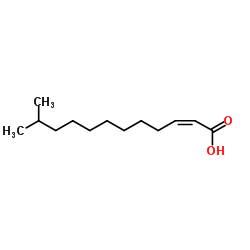cis-11-Methyl-2-dodecenoic acid

cis-11-Methyl-2-dodecenoic acid structure
|
Common Name | cis-11-Methyl-2-dodecenoic acid | ||
|---|---|---|---|---|
| CAS Number | 677354-23-3 | Molecular Weight | 212.329 | |
| Density | 0.9±0.1 g/cm3 | Boiling Point | 322.3±11.0 °C at 760 mmHg | |
| Molecular Formula | C13H24O2 | Melting Point | N/A | |
| MSDS | Chinese USA | Flash Point | 226.5±10.2 °C | |
| Symbol |


GHS07, GHS09 |
Signal Word | Warning | |
|
Subgenomic promoter recognition by the norovirus RNA-dependent RNA polymerases.
Nucleic Acids Res. 43(1) , 446-60, (2015) The replication enzyme of RNA viruses must preferentially recognize their RNAs in an environment that contains an abundance of cellular RNAs. The factors responsible for specific RNA recognition are not well understood, in part because viral RNA synthesis tak... |
|
|
A nanoparticle formulation of disulfiram prolongs corneal residence time of the drug and reduces intraocular pressure.
Exp. Eye Res. 132 , 115-23, (2015) The goal in the search for successful therapies for glaucoma is the reduction of intraocular pressure (IOP), and the search for effective eye drops that reduce IOP is a high priority. We previously reported the potential of a 2-hydroxypropyl-β-cyclodextrin (H... |
|
|
Exploiting light chains for the scalable generation and platform purification of native human bispecific IgG.
Nat. Commun. 6 , 6113, (2015) Bispecific antibodies enable unique therapeutic approaches but it remains a challenge to produce them at the industrial scale, and the modifications introduced to achieve bispecificity often have an impact on stability and risk of immunogenicity. Here we desc... |
|
|
Disulfiram modulates stemness and metabolism of brain tumor initiating cells in atypical teratoid/rhabdoid tumors.
Neuro. Oncol. 17 , 810-21, (2015) Atypical teratoid/rhabdoid tumors (AT/RT) are among the most malignant pediatric brain tumors. Cells from brain tumors with high aldehyde dehydrogenase (ALDH) activity have a number of characteristics that are similar to brain tumor initiating cells (BTICs). ... |
|
|
Angiomotin binding-induced activation of Merlin/NF2 in the Hippo pathway.
Cell Res. 25 , 801-17, (2015) The tumor suppressor Merlin/NF2 functions upstream of the core Hippo pathway kinases Lats1/2 and Mst1/2, as well as the nuclear E3 ubiquitin ligase CRL4(DCAF1). Numerous mutations of Merlin have been identified in Neurofibromatosis type 2 and other cancer pat... |
|
|
Structural insights into WcbI, a novel polysaccharide-biosynthesis enzyme.
IUCrJ 1 , 28-38, (2014) Capsular polysaccharides (CPSs) are protective structures on the surfaces of many Gram-negative bacteria. The principal CPS of the human pathogen and Tier 1 select agent Burkholderia pseudomallei consists of a linear repeat of --3)--2-O-acetyl-6-deoxy-β-d-man... |
|
|
Direct inhibition of oncogenic KRAS by hydrocarbon-stapled SOS1 helices.
Proc. Natl. Acad. Sci. U. S. A. 112(6) , 1761-6, (2015) Activating mutations in the Kirsten rat sarcoma viral oncogene homolog (KRAS) underlie the pathogenesis and chemoresistance of ∼ 30% of all human tumors, yet the development of high-affinity inhibitors that target the broad range of KRAS mutants remains a for... |
|
|
An Atomic Force Microscope Study Revealed Two Mechanisms in the Effect of Anticancer Drugs on Rate-Dependent Young's Modulus of Human Prostate Cancer Cells.
PLoS ONE 10 , e0126107, (2015) Mechanical properties of cells have been recognized as a biomarker for cellular cytoskeletal organization. As chemical treatments lead to cell cytoskeletal rearrangements, thereby, modifications of cellular mechanical properties, investigating cellular mechan... |
|
|
Experimental strategies for functional annotation and metabolism discovery: targeted screening of solute binding proteins and unbiased panning of metabolomes.
Biochemistry 54(3) , 909-31, (2015) The rate at which genome sequencing data is accruing demands enhanced methods for functional annotation and metabolism discovery. Solute binding proteins (SBPs) facilitate the transport of the first reactant in a metabolic pathway, thereby constraining the re... |
|
|
Quantifying the stabilizing effects of protein-ligand interactions in the gas phase.
Nat. Commun. 6 , 8551, (2015) The effects of protein-ligand interactions on protein stability are typically monitored by a number of established solution-phase assays. Few translate readily to membrane proteins. We have developed an ion-mobility mass spectrometry approach, which discerns ... |